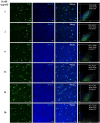4',6-Diamidino-2-Phenylindole Distinctly Labels Tau Deposits
- PMID: 30106598
- PMCID: PMC6158628
- DOI: 10.1369/0022155418793600
4',6-Diamidino-2-Phenylindole Distinctly Labels Tau Deposits
Abstract
Tau deposits have distinct biochemical characteristics and vary morphologically based on identification with tau antibodies and several chemical dyes. Here, we report 4',6-diamidino-2-phenylindole (DAPI)-positivity of tau deposits. Furthermore, we investigated the cause for this positivity. DAPI was positive in 3R/4R (3-repeat/4-repeat) tau deposits in Alzheimer's disease, myotonic dystrophy, and neurodegeneration with brain iron accumulation, and in 4R tau deposits in corticobasal degeneration, but negative in 4R tau deposits in frontotemporal dementia with parkinsonism-17 and progressive supranuclear palsy. The peak emission wavelength of DAPI after binding to a tau deposit was similar to that after binding to a nucleus. This DAPI-positivity was conspicuous at the optimum concentration of 2 μg/ml. DAPI-positivity was diminished after formic acid treatment, but preserved after nucleic acid elimination and phosphate moiety blocking. Our results suggest that staining with 2 μg/ml DAPI is a common but useful tool to differentially detect tau deposits in various tauopathies.
Keywords: 4′,6-diamidino-2-phenylindole; Phos-tag; neurofibrillary tangle; tauopathies.
Conflict of interest statement
Figures







Similar articles
-
Argyrophilic grain disease is a sporadic 4-repeat tauopathy.J Neuropathol Exp Neurol. 2002 Jun;61(6):547-56. doi: 10.1093/jnen/61.6.547. J Neuropathol Exp Neurol. 2002. PMID: 12071638
-
Phosphorylated mitogen-activated protein kinase (MAPK/ERK-P), protein kinase of 38 kDa (p38-P), stress-activated protein kinase (SAPK/JNK-P), and calcium/calmodulin-dependent kinase II (CaM kinase II) are differentially expressed in tau deposits in neurons and glial cells in tauopathies.J Neural Transm (Vienna). 2001;108(12):1397-415. doi: 10.1007/s007020100016. J Neural Transm (Vienna). 2001. PMID: 11810404
-
Ultrasensitive and selective detection of 3-repeat tau seeding activity in Pick disease brain and cerebrospinal fluid.Acta Neuropathol. 2017 May;133(5):751-765. doi: 10.1007/s00401-017-1692-z. Epub 2017 Mar 14. Acta Neuropathol. 2017. PMID: 28293793
-
The neuropathological spectrum of neurodegenerative tauopathies.IUBMB Life. 2003 Jun;55(6):299-305. doi: 10.1080/1521654032000114348. IUBMB Life. 2003. PMID: 12938731 Review.
-
Invited review: Neuropathology of tauopathies: principles and practice.Neuropathol Appl Neurobiol. 2015 Feb;41(1):3-23. doi: 10.1111/nan.12208. Neuropathol Appl Neurobiol. 2015. PMID: 25495175 Review.
References
-
- Ferrer I, López-González I, Carmona M, et al. Glial and neuronal tau pathology in tauopathies: characterization of disease-specific phenotypes and tau pathology progression. J Neuropathol Exp Neurol. 2014;73(1):81–97. - PubMed
-
- Mackenzie IRA. Neuropathology of atypical parkinsonian disorder. In: Litvan I, editor. Atypical parkinsonian disorders: clinical and research aspects. Current clinical neurology. Totowa, NJ: Humana Press; 2005:47–77.
Publication types
MeSH terms
Substances
LinkOut - more resources
Full Text Sources
Other Literature Sources

